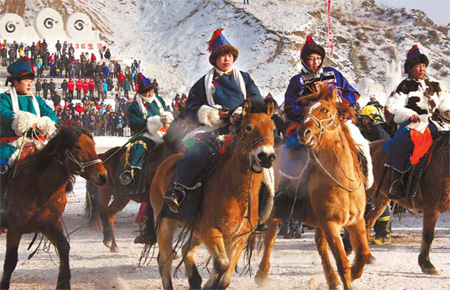
Mongols showcase their ethnic culture in the Inner Mongolia Hulunbuir Ice and Snow Festival.
 |
|
Mongols showcase their ethnic culture in the Inner Mongolia Hulunbuir Ice and Snow Festival. |
Freezing temperatures open up a wonderful world of ice and snow, in Northeast China, where millions of people from all over the world converge every year.
The Harbin Ice and Snow Festival, which begins officially on Jan 5, in Heilongjiang province, is arguably the longest-running ice and snow festival in the world. Preparations for it are well underway this month and the festival goes on till late February, covering New Year, Spring Festival and the Lantern Festival.
First launched in 1985, it is one of the world's four largest ice and snow festivals, along with Japan's Sapporo Snow Festival, Canada's Quebec City Winter Carnival and Norway's Ski Festival.
Besides the classic attractions, such as ice and snow sculptures, weddings on ice, skiing, ice painting competitions, photography competitions. This year's festival will focus on five themes - ice and snow arts, culture, sports, business, and travel - to appeal to the broadest cross-section of people.
Mass-participation events, such as the making of snowmen, professional sports competitions, exhibitions and music shows, will turn Harbin into a fairyland, that is bound to thrill not just children but also adults.
If natural scenery is more to your liking, go to neighboring Jilin province. Also located in the northeast of China, Jilin is well-known for its rime, the white ice that forms when water droplets in fog freeze and cling to the outer surfaces of objects, such as trees. Jilin's "ice flowers" rank with the three other natural wonders of China - the mountains and waters of Guilin, the Stone Forest of Yunnan, and the Three Gorges of the Yangtze River.
In contrast to the excitement in Harbin, the Jilin Rime Festival is a more laid back affair, offering not only a fascinating visual feast of unique natural phenomenon, but also an invigorating hot spring bath.
The Inner Mongolia Hulunbuir Ice and Snow Festival weaves more ethnic elements into its events. The Mongol, Ewenki, Daur, Oroqen and other minorities showcase their rich culture through the festival's activities, performances, costumes and even ice sculptures.
For instance, you may find a Matouqin-shaped (horse-head string instrument) ice sculpture at this festival, a representative element of Mongol culture that is not found in any other ice and snow festival around the world.
So stop complaining about how cold it's getting. Just grab your camera, don a thick down coat, and explore a paradise of ice and snow.